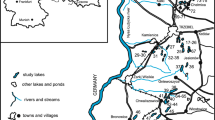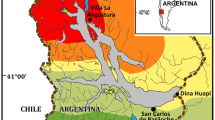Abstract
Two hundred and forty water samples (in four seasons) and seventeen sediment samples have been analyzed to monitor the natural and anthropogenic influences on the water and sediment chemistry of the Dal Lake, Kashmir Himalaya. The scatter diagrams [(Ca+Mg)/total cations (TZ+), (Ca+Mg)/HCO3, (Ca+Mg)/(HCO3+SO4), (Na+K)/TZ+; (Ca+Mg)/(Na+K)] and the geological map of the study area suggest predominance of carbonate and silicate weathering. Lower pH and high total dissolved solids, electrical conductivity and \( {\text{NO}}^{ - }_{{\text{3}}} \) values in the Gagribal basin and in some patches of other basins reflect anthropogenic inputs in the form of sewage from surrounding population, houseboats, hotels, etc. The Dal Lake is characterized by high chemical index of alteration (CIA: 87–95), reflecting extreme weathering of the catchment area. Relative to the average carbonates, the lakebed sediments are enriched in Al, Ti, Zn, Cu and Co and depleted in Ni and Mn. Compared to the post-Archean Shale the sediments have higher Al, Zn and Cu contents and lower Ni and Co. There are distinct positive anomalies of Al, Mn, Zn and Cu and negative anomalies of Ni and Pb with respect to the upper continental crust. Geoaccumulation index (I geo) and the US Environmental Protection Agency sediment quality standards indicate that the Gagribal basin and some patches of the Nagin basin are polluted with respect to Zn, Cu and Pb. These data suggest that the Dal Lake is characterized by differential natural and anthropogenic influences.







Similar content being viewed by others
References
APHA, AWWA, WPCF (1996) Standard methods for the examination of water and waste. American Public Health Association, Washington DC
Baudo R, Geisy JP, Muntau H (1990) Sediments-chemistry and toxicity of in-place pollutants. Lewis Publishers Ann Arbor, pp 1–3
Bhat DK (1989) Geology of Karewa basin, Kashmir. Geol Sur India Records p 122
Calmano W, Ahlf W, Förstner U (1996) Sediment quality assessment: chemical and biological approaches In: Calmano W, Förstner U (eds) Sediments and toxic substances. Springer Berlin, Heidelberg, New York, pp 1–35
Chapman PM (1986) Sediment quality criteria from the sediment quality triad. An example. Env Tox Chem 5:957–964
Chakrapani GJ (2002) Water and sediment geochemistry of major Kumaon Himalayan Lakes India. Env Geol 43:99–107
Chebotarev II (1955) Metamorphism of natural waters in the crust of weathering. Geochim Cosmochim Acta 8:22–48
Christensen VG, Juracek KE (2001) Variability of metals in reservoir sediment from two adjacent basins in the central Great Plains. Env Geol 40(4–5):470–481
Datta NK (1983) Geology, evolution and hydrocarbon prospects of Kashmir Valley. Pet Asia J 171–177
Dessert C, Dupre B, Francois LM, Schott J, Gaillardet J, Chakrapani G, Bajpai S (2001) Erosion of Deccan Traps determined by river geochemistry: impact on the global climate and Sr/Sr ratio of seawater. Earth Planet Sci Lett 188:459–474
Dunne T (1978) Rates of chemical denudation of silicate rocks in tropical catchments. Nature 274:244–246
ENEX (1978) Study of the pollution of Dal Lake Srinagar Kashmir. ENEX Consortium, New Zealand
Freeze RA, Cherry JA (1979) Groundwater. Prentice Hall, Englewood Cliffs, NJ
Fernex F, Valle PZ, Sanchez RH, Michand F, Parron C, Dalmasso J, Genevieve BF, Manuel GA (2001) Sedimentation rates in Lake Chapala (Western Mexico): possible active tectonic control. Chem Geol 177:213–228
Förstner U (1989) Contaminated sediments lecture notes in earth sciences. Springer, Berlin Heidelberg, NewYork
Förstner U, Müller G (1973) Heavy metals accumulations in river sediments: a response to environmental pollution. Geoforum 14:53–71
Förstner U, Wittmann GTW (1983) Metal pollution in the aquatic environment. Springer, Berlin Heidelberg New York
Gibbs RJ (1970) Mechanism controlling world water chemistry. Science 170:1088–1090
Gupta LP, Subramanian V (1998) Geochemical factors controlling the chemical nature of water and sediments in the Gomti river. India Env Geol 36 (1–2):102–108
Holland HD (1978) The chemistry of the atmosphere and oceans. Wiley, New York
Ingersoll CG, Haverland PS, Brunson EL, Canfield TJ, Dwyer FJ, Henke CE, Kemble NE, Mount DR, Fox RG (1996) Calculation and evaluation of sediment effect concentrations for the amphipod Hyalella azteca and the midge Chironomus riparius. J Great Lakes Res 22(3):602–623
Ingri J, Widerlund A (1994) Uptake of earth and alkaline earth elements on suspended iron and manganese in the Kalix River northern Sweden. Geochim Cosmochim Acta 58:5433–5442
Irabien MJ, Velasco F (1999) Heavy metals in Oka river sediments (Urdaibai National Biosphere Reserve northern Spain): lithogenic and anthropogenic effects. Env Geol 37 (1–2):54–63
Jeelani G (2005) Chemical quality of the spring waters of Anantnag, Kashmir. J Geol Soc Ind 66:453–462
Johansson K, Iverfeldt A (1994) The relation between mercury content in the soil and the transport of mercury from small catchments in Sweden. In: Watras CJ, Huckabee JW (eds) Mercury pollution, integration and synthesis. Lewis, Boca Raton pp 323–328
Koussouris T, Diapoulis A (1989) Lake Mikri Prespa. Ecological changes from natural and anthropogenic causes. Toxicol Environ Chem 20:49–52
Koussouris T, Diapoulis A, Balapoulos E (1987) Limnological situations in two shallow Greek lakes. Geojournal 14:377–379
Krishnaswami S, Singh SK (1998) Silicate and carbonate weathering in the drainage basins of the Ganga–Ghaghra–Indus head waters: contributions to major ion and Sr isotope geochemistry. Pr Ind Acad Sci (Earth Planet Sci) 107(4):283–291
McLennan SM (1993) Weathering and Global denudation. J Geol 101:295–303
Mclennan SM., Taylor SR (1991) Sedimentary rocks and crustal evolution; tectonic setting and secular trends. J Geol 99:1–21
Moore JW, Ramamoorthy S (1984) Heavy metals in natural waters: applied monitoring and impact assessment. Springer, New York, Berlin, Heidelberg pp 268
Müller G (1979) Schwermetalle in den sediment des Rheins-Vernderungen seit 1971. Umschau 79(24):778–783
Nag JK, Das A K (1993) Trace metal levels in drinking water scenario of Hooghly district. Ind J Environ Protect 13:20–22
Nesbitt HW, Young GM (1982) Early Proterozoic climates and plate motions inferred from major element chemistry of lutites. Nature 299:715–717
Raymahashay BC (1986) Geochemistry of bicarbonate in river water. J Geol Soc Ind 27(1):114–118
Sarin M M, Krishnaswami S (1984) Major ion chemistry of the Ganga-Brahamputra river systems India. Nature 312:538–541
Sarin MM, Krishnaswami S, Dilli K, Somayajulu BLK, Moore WS (1989) Major ion chemistry of Ganga–Brahamputra river systems: weathering processes and fluxes to the Bay of Bengal. Geochem Cosmochim Acta 54:997–1009
Shapiro L, Brannock WW (1962) Rapid analyses of silicate, carbonate and phosphate rocks. USGS Bull 1144A:A1−A32
Singh AK, Hasnain I (1999) Environmental geochemistry of Damodar River basin, east coast of India. Env Geol 37 (1–2):124–136
Skoulikidis NT, Bertahas I, Koussouris T (1998) The environmental state of freshwater resources in Greece (rivers and lakes). Env Geol 36(1–2):1–17
Sujatha SD, Sathyanarayanan S, Satish PN, Nagaraju D (2001) A sewage and sludge treated lake and its impact on the environment Mysore India. Env Geol 40:1209–1213
Taylor SR, Mclennan SM (1985) The continental crust: its composition and evolution. Blackwell, Oxford pp 312
Thuy HTT, Tobschall HJ, An PV (2000) Trace element distributions in aquatic sediments of Danang-Hoian area, Vietnam. Env Geol 39(7):733–740
Turekian SR, Wedepohl KH (1961) Distribution of the elements in some major units of the Earths crust. Geol Soc Amer Bull 72:175–192
Trisal CL (1987) Ecology and conservation of Dal Lake Kashmir. Water Resources Dev 3:44–54
Trivedi RK, Goel PK (1984) Chemical and biological methods for water pollution studies. Env Publ Karad, India pp 215
USEPA (1997) The incidence and severity of sediment contamination in surface waters of the United States. National sediment quality survey US Environmental Agency Report 1:823-R-97–006
Varadan VKS (1977) Geology and mineral resources of the state of India Part X Jammu and Kashmir state. Geol Sur Ind 30:1–71
Wadia DN (1971) Geology of India. Tata McGraw Hill, New Delhi pp 344
WHO (1993) International standards for drinking water. World Health Organization, Geneva
Zutshi DP, Vass KK (1978) Limnological studies on Dal Lake Srinagar: chemical features. Ind J Ecol 5:90–97
Acknowledgements
The authors would like to thank Chairman, Dept. of Geology, AMU, Aligarh and Director CORD, University of Kashmir for providing laboratory facilities. The anonymous reviewers are greatly appreciated.
Author information
Authors and Affiliations
Corresponding author
Rights and permissions
About this article
Cite this article
Jeelani, G., Shah, A.Q. Geochemical characteristics of water and sediment from the Dal Lake, Kashmir Himalaya: constraints on weathering and anthropogenic activity. Environ Geol 50, 12–23 (2006). https://doi.org/10.1007/s00254-005-0168-y
Received:
Accepted:
Published:
Issue Date:
DOI: https://doi.org/10.1007/s00254-005-0168-y




